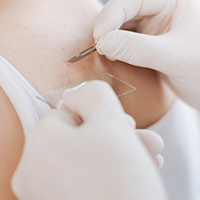
Great looking, healthy nails can finish off your look and it can be frustrating when they split, peel or change colour, but did you know changes like these in your nails can point to a deeper health issue?
So let’s talk nails
Fingernails and toenails are essential parts of our body’s protective layer. Made of laminated layers of the protein keratin, they grow from the cuticle at the base of the nail and protect the sensitive tips of our fingers and toes.
Nails are normally smooth, without pits or grooves, and consistent in colour, free of spots or discoloration. They can sometimes develop vertical ridges and white lines or spots due to minor injury, but these are usually harmless and grow out as the nail grows.
Keeping nails healthy
To keep your nails healthy, Dermatologist and Fellows of the Australasian College of Dermatologists Associate Professor Johannes Kern gives some hints and tips on caring for your nails:
- Keep your fingernails dry and clean and use gloves for activities such as washing the dishes as repeatedly wetting your nails can cause them to become dry and brittle, leading to them splitting.
- Practice good nail maintenance by using sharp clippers or scissors when trimming your nails. Trim your nails, especially toenails straight across to avoid ingrowing nails.
- Use hand or foot lotion to moisturise your skin, nails and cuticles.
- Avoid biting your fingernails as this can damage the nailbed and increase the risk of a bacterial or fungal infection.
- Don’t tear off hangnails as this can also tear away skin tissue around the nail. Use nail scissors or clippers instead to carefully cut off the hangnail.
- Limit the use of nail polish remover and ensure you’re using an acetone-free product as acetone can dry out the nails leading to splitting and peeling.

What to look out for
If you notice an imperfection in your nail that is not caused by injury and does not grow out with the nail, this could point to a more significant underlying condition. If this is the case, seeking medical advice from your General Practitioner (GP) is recommended. Your GP may then refer you to a dermatologist who are specialists in diagnosing and treating skin, hair and nail conditions.
Discoloration or change of texture
Discoloration of the nails can be a sign of an underlying health issue. Nails that become thickened and yellow can indicate a fungal infection, psoriasis or eczema. A nail biopsy by a health practitioner is required to determine the underlying condition.
Dark streaks
A dark streak under the nail that is new or changing could have different causes, including melanoma, a type of skin cancer, and should be examined by a dermatologist right away.
Pitting
Small dents or dimples in the nail can be a sign of an underlying condition such as eczema, psoriasis, or alopecia areata.
Injury
A more significant injury to the nail can sometimes lead to subungual haematoma, where blood is trapped under the nail, causing discoloration. Severe injuries can lead to the nail being deformed. A dermatologist may drain the fluid built up under the nail to treat the injury.
Brittle, soft, or splitting nails
Brittle or softening nails are common as we age but could be related to underlying causes such as iron deficiency, psoriasis, lupus, alopecia, vitiligo or Hashimoto’s disease.

Effective treatments for nail conditions
The methods of treating nail conditions are as varied as the nail conditions themselves. It is always best to seek treatment for nail conditions as early as possible by seeing your General Practitioner who may refer you to a dermatologist, a specialist in skin, hair and nail conditions for diagnosis and treatment. Dermatologists are skilled at identifying, managing and treating underlying conditions as well as acute conditions.

Associate Professor Johannes Kern is a dermatologist and Fellow of the Australasian College of Dermatologists
